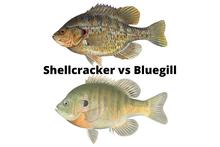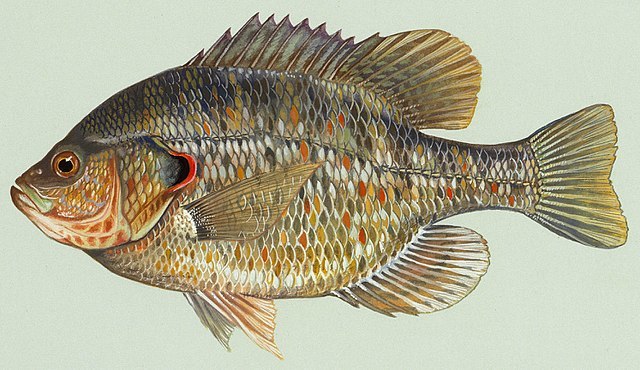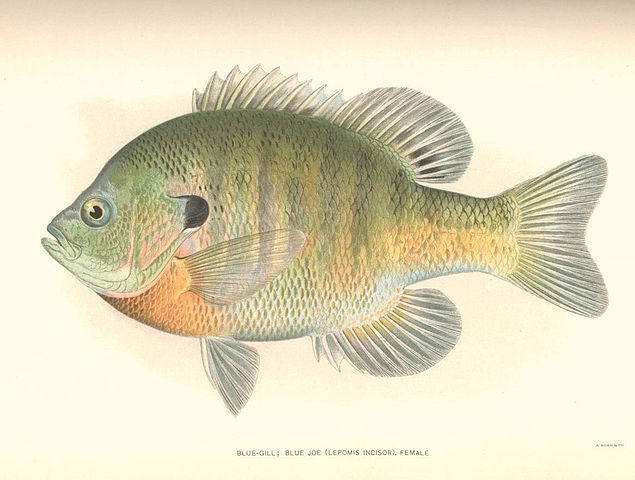This article may contain affiliate links. If you make a purchase after clicking on a link we may earn a small commission at no extra cost to you. As an Amazon Associate, I earn from qualifying purchases.
Shellcracker vs Bluegill – What’s the Difference?

Sunfish are one of the more prevalent species of fish found throughout North America. With more than 30 different species in the sunfish family, it’s sometimes tough for even experienced anglers to know the difference between certain species, especially when it come to shellcracker vs bluegill.
In this article, we’ll cover some of the major differences between shellcracker vs bluegill and discuss various ways you can identify both species.
Shellcracker vs Bluegill
The shellcracker is a common nickname for a popular sunfish species called a redear sunfish. The nickname is mostly derived from the fact that the redear sunfish often eats small snails, mussels and other creatures that have shells. The shellcracker has deep-set teeth which they use to crush and break shells in order to devour the organism living inside.
Bluegill are also very popular throughout many of the freshwater lakes and rivers throughout North America. They are often found alongside shellcrackers and many other species of panfish and sunfish, which usually makes it difficult to tell them apart.
Also Read: Bluegill vs Sunfish
Their behavior and habitat are very similar, but there are some distinct differences between shellcracker and sunfish that you can use to distinguish these types of fish from one another.
In the following sections, we’ll discuss shellcracker and bluegill in more detail and cover some of the ways anglers use physical features, characteristics and other traits to tell shellcracker and bluegill apart from one another.
What is a Shellcracker Fish?
The common redear sunfish, or shellcracker, is very similar to bluegill in many ways. There are many similarities between these two fish species that make it difficult for even experienced anglers to tell them apart. The shellcracker’s scientific name is Lepomis microlophus, but the fish is known by various nicknames that include Georgia bream, red gills, chinquapin and others.

Many novice and beginner anglers commonly mistake these fish for bluegill or refer to them as ‘bream.’ It’s similar in shape to many other sunfish species, but shellcrackers typically have a deep body profile and a very small mouth. When compared to other sunfish, the shellcracker’s mouth is usually much smaller than most other variations.
Their diet consists mostly of snails and mussels, but shellcrackers will also eat almost any kind of insect, small grubs or other creatures they find in their natural habitat. Their fins are oriented in such a way as is common to most other sunfish species and they are virtually indistinguishable from bluegill to the casual observer. Shellcracker also have the distinct black spot in their ‘ear’ position that many other sunfish species also possess.
When it comes to the specific habitat or location where you might find shellcrackers, they live mostly in the southeastern United States and are not known to live in any freshwater bodies of water in the northern reaches of America. They have been introduced to places like California, Michigan and Kansas, but their natural boundaries are around the southernmost states in an area commonly referred to as the Deep South.
What is a Bluegill?
Bluegill are probably the most common freshwater fish found throughout North America, especially in the southeastern portion of the continent. They are not necessarily a large species of fish, but they typically school together in groups in order to ward off any predators or other threats.
Many freshwater game fish species such as bass, walleye, muskies and others often seek out bluegill as a staple part of their diet, making bluegill an integral part of any freshwater ecosystem.

These fish are scientifically known as Lepomis macrochirus, but are given a slew of nicknames by anglers that include coppernose, bream, brim, blues, sunny and others. While it is true that bluegill are often the prey when it comes to their relationship with other larger freshwater fish species, they are known to be opportunistic predators in their own right. Bluegill commonly feed on a wide variety of insects, frogs, smaller fish, and other creatures found in their habitat.
The native habitat of bluegill is much of the freshwater lakes and rivers throughout the southern half of the North American continent, but in the last century they have been introduced to western states like California and are known to thrive in parts of southern Canada as well.
Shellcracker vs Bluegill Size
It’s well-known that both shellcracker and bluegill are considerably smaller than many other freshwater species that live within the same bodies of water where these fish are found. However, they can grow to immense sizes in the right conditions and with an optimal diet. A mature, hefty bluegill or shellcracker will put up a ferocious fight against any angler’s rod and reel as they use their wide and powerful frame to dive and pull towards the bottom.
Shellcracker are actually the largest fish in the sunfish family. They are capable of growing at a much faster rate than their relatives and a full-grown shellcracker often reaches a length of 7 to 12 inches and a weight of roughly 1 pound. However, it’s not uncommon for shellcracker to grow to more than 2 or 3 pounds in the right conditions.
Areas that have warm climate and plentiful food often produce giant shellcrackers. The current IGFA world record for shellcracker (redear sunfish) is a 6-pound, 4-ounce monster that was caught in Lake Havasu, Arizona in 2021.
Bluegill are capable of growing to roughly the same size as shellcracker if they have ample food and live in a warm climate that offers a long growing season. These fish typically grow to about 8 to 12 inches in length and might weigh-in anywhere from 1 to 2 pounds in most areas. Like shellcracker, bluegill are capable of reaching extreme sizes compared to other sunfish varieties.
The IGFA world record bluegill was caught decades ago in 1950. The fish came out of Alabama’s Ketona Lake and tipped the scales at a whopping 4-pounds, 12-ounces. There have been many cases in which anglers claimed to have caught bluegill that weighed more than 5 pounds, but none of these fish were weighed on certified scales.
Differences Between Shellcracker and Bluegill
There are some obvious differences between bluegill and shellcracker, as well as other things about each species that are only evident to experienced anglers who know what to look for. If you’re hoping to be able to quickly and confidently identify the differences between shellcracker and bluegill, the following items should be taken into consideration.
Ears
The most common way anglers usually distinguish shellcrackers from bluegill is to look at the fish’s operculum, which is often referred to as the fish’s ‘ear.’ When it comes to bluegill, this ear will be completely black and will be very easy to identify as it clearly stands out against the green, blue and orange colors around the fish’s gills.
The shellcracker is known as a redear sunfish because of the appearance of this species’ operculum. Shellcrackers have a black ear that features a very bright red-colored outline. This red color will stand out against the fish’s light gray, green or even copper-toned scales along the side of its body.
Fins and Tail Color
The shellcracker’s fins and tail often have a shape and orientation that’s virtually identical to that of a bluegill. However, a shellcracker’s fins are always going to be lighter in color and will usually have a yellow or olive tint. The bluegill’s fins and tail will always be much darker and will appear to be dark green in color.
Eye Color
Another way you can tell the difference between a shellcracker and bluegill is to look closely at the color of the fish’s eye. Bluegill will usually have a very dark green complexion when it comes to their scales, fins and even their eye-color. The bluegill’s iris will have a dark green color while the pupil will always be jet black.
A shellcracker’s eye is distinctly different when compared to a bluegill as the color is obviously brighter. Shellcrackers have an iris that’s bright red or orange in color and might even appear to be yellow in some cases. The shellcracker’s pupil will be black, but the fish’s eye color is a marked difference from the bluegill’s dark green iris.
Body Shape
The shellcracker’s body profile or shape is always going to appear more elongated than a bluegill. Many anglers describe the shellcracker as having a ‘pointed nose’ compared to the bluegill’s more bulky appearance that makes the fish look more round and stout instead of longer in shape. In most cases, a bluegill’s body will have more girth or thickness compared to a shellcracker.
Conclusion
If you’re planning to go fishing for sunfish, you might encounter both bluegill and shellcracker in the same parts of any body of water. Using the information we’ve laid out in this article, as well as the four ways you can tell the difference between each species, you can easily identify whether your fish is a shellcracker or bluegill.
